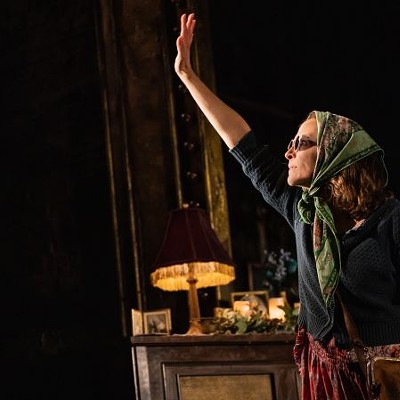The exhibition "Texas Before the Boom, 1850-1900: Selections from the Bobbie and John L. Nau Collection," currently on view at the Pearl Fincher Art Museum in Spring, consists of 40 or so paintings and drawings made in Texas or by Texans, mostly before 1900. Since most people, when they think of Texas art -- especially the old stuff -- probably think first of bluebonnets, cowboys and longhorn cattle, this show might just as aptly be titled Texas Art Before the Clichés. There's not a single blue-bonnet or cowboy, and only one longhorn, in the show.
To be fair, there's nothing inherently wrong with any of those subjects, all of which came along big time for Texas artists after the turn of the 20th century. Even bluebonnet paintings can be good -- it's all in the execution, and those illusive qualities that transform a painting into art. But the works in this show are especially intriguing in part because the subjects are so different from those conventional ideas of what makes a work "Texas art."
But why, you may be wondering, should you care about a show of Texas art anyway, and why this particular show? To address the second question first, the Nau Collection, encompassing all phases of earlier Texas art, is one of the largest and most comprehensive there is. Though only a fraction of the whole, the works included here are some of the earliest and rarest of their kind anywhere.
Some people pooh-pooh work identified as "Texas Art" -- especially the old stuff -- as trivial. Many working artists bristle at being labeled (and limited, so they think) Texas artists. But there's something to be learned from acknowledging and understanding the place-ness of art. Why else are almost all our art museums organized by geography: American, Italian, Euorpean, Asian? And who thinks less of Monet when they call him a French artist? The challenge is figuring out how that place factor, both place of subject and place of creation, shapes the art and the messages we get from it. That's what collections such as the Nau Collection can help us with.
The Pearl Fincher is one large gallery, with a smaller separate area toward the back, currently devoted to another show. The Nau Collection works, most made during what we know as the Impressionist era, are quite small, as paintings in that period often were. For me, the mashup of large space/small paintings works to advantage, making me and each painting as I look at it a tight unit within a Texas-like wide-open space.
The day I saw the show the wall tags had not yet gone up. Even though I have a good grounding in Early Texas Art (full disclosure: I'm on the Board of CASETA, Center for the Advancement and Study of Early Texas Art), pigeonholing the works by artist, place and date was a fun guessing game that forced me to look closely at each piece for clues. I may never look at wall tags again -- at least not first.
These works are so early (for Texas) and so rare that there will be revelations for even the most seasoned viewer -- chief among them the several paintings, works on paper and piles of sketchbooks by Thomas Allen (1849-1924). Allen was a St. Louis-born, Boston- and Europe-trained artist who visited Texas during the winters of 1877-79. His Galveston Beach of 1877 is gorgeous -- wedges of sand and water converging in the distance below a rectangle of sky, clouds echoing waves, no people, no buildings, reduced almost to a modernist study of geometry and subtle color. Likewise his The Blue and White Serape, which has the casual, unfinished feel of a sketch and speaks to the Mexican heritage of Texas, as do many of the works in the show.
Allen is also the author of the only longhorn in the show, Longhorn Steer, Notched Ear, a painting of a longhorn's head against a neutral ground. The frontality of the image reminded me of Georgia O'Keeffe's Cow's Skull -- Red, White and Blue of 1931, though the two paintings present very different views of a Southwest, either living and vital, or ominous and desiccated, depending on the artist and the age.
Julian Onderdonk (1882-1922), chief exponent if not actual inventor of the bluebonnet painting -- though under his brush bluebonnets could be magnificent -- studied with William Merrit Chase and spent several years working in New York before he returned to San Antonio permanently in 1909. In this show, his early watercolor, Untitled (Mission San Jose), from 1899, is the work of a young artist, less sophisticated than he would become, which thus makes a provocative contrast to his later work.
A tablescape of a wine decanter and glasses and fruit arrayed on a cloth, by Eloise Polk McGill (1868-1939), is a rough and ready frontier rendition of a subject painted often by the likes of Manet and Renoir. And a direct, muted portrait of the artist's wife by Louis Grenet (1856-1922), with the sitter slightly askew, head tilted, looking directly at us, the only portrait in the show, has stayed with me for days.
The most intriguing work is The Burning of the Heroes of the Alamo from 1903 by José Arpa y Perea (1858-1952). Arpa was a Spanish artist, trained in Seville and Rome, who spent decades in San Antonio before returning to Spain in 1932. The work here is richly painted and complex, befitting his Spanish training: A painting of the burning Alamo surrounded by greenery sits before a female figure (is she a nun, an allegorical reference, something else?) holding an hourglass or maybe an urn containing the ashes of the heroes. I appreciated the beauty of many of the works in the show; but with this one, I both appreciated the beauty and, even after a long look, left wanting to know more.
For those who live inside the loop, getting to the Pearl Fincher is a schlep. It's a pack-a-lunch-and-make-a-day-of-it excursion (which you can actually do, especially if it's a beautiful day, by stopping also at Mercer Arboretum or some other North County gem we don't often get to). This show is a good reason to make the trip. You're unlikely to get a chance to see early Texas art closer to the center of town, and you can seldom see early Texas art of this quality and rarity anywhere.
Through December 13, Monday to Wednesday and Friday to Saturday 10 a.m. to 5 p.m., and Thursday 10 a.m. to 8 p.m., at Pearl Fincher Museum of Fine Arts, 6815 Cypresswood Drive, Spring, TX 77379 281-376-6322, www.pearlmfa.org.






